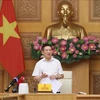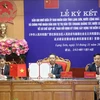Economic experts have warned that Vietnam must restructure its economy or the country will be off-track in its development path.
Luu Bich Ho, former Director of the Development Strategy Institute at the Ministry of Planning and Investment, said while the business environment has improved, particularly with the Government’s programme to reform administrative procedures towards catching up with the business environment of the top four ASEAN economies in 2016, the country is just making the first steps of restructuring, with no obvious change in the growth model.
Nguyen Tu Anh, Deputy Head of the macro-economic policy section under the Central Institute for Economic Management (CIEM), highlighted the nation’s significant achievements in curbing inflation, stabilising its macro-economy, increasing the national safety index and improving business environment and labour productivity.
He noted that inflation peaked at 28.32 percent in August 2008 and has gradually returned to normal from July 2012 to the present, while loan interest rates were curbed after measures to restructure the banking system took effect in early 2012.
However, he warned that the risk of macro-economic instability still exists due to slow equitisation of State-run businesses and the handling of bad debts. Public investment restructuring has yet to focus on measures to improve the efficiency of investment and avoid investment waste, he added.
Director of the CIEM Nguyen Dinh Cung said restructuring the economy is to change institutions and mechanisms for the allocation, management and utilisation of national resources, particularly investment capital, towards a more effective and highly competitive economic structure. He added that the re-allocation of national resources should not be done by the State but be prompted by the market.
Le Xuan Ba, former Director of the the CIEM, said restructuring the economy successfully requires a high price, which means to accept a modest growth of 4-5 percent in the short term in order to have higher growth of 8-10 percent in the middle term.
To boost economic restructuring and shift growth models, experts suggested maintaining macro-economic stability with low inflation while establishing and developing institutions for the market economy and creating fair and transparent playing grounds for businesses with low risk levels, high-quality human resources and synchronous infrastructure systems.-VNA
Luu Bich Ho, former Director of the Development Strategy Institute at the Ministry of Planning and Investment, said while the business environment has improved, particularly with the Government’s programme to reform administrative procedures towards catching up with the business environment of the top four ASEAN economies in 2016, the country is just making the first steps of restructuring, with no obvious change in the growth model.
Nguyen Tu Anh, Deputy Head of the macro-economic policy section under the Central Institute for Economic Management (CIEM), highlighted the nation’s significant achievements in curbing inflation, stabilising its macro-economy, increasing the national safety index and improving business environment and labour productivity.
He noted that inflation peaked at 28.32 percent in August 2008 and has gradually returned to normal from July 2012 to the present, while loan interest rates were curbed after measures to restructure the banking system took effect in early 2012.
However, he warned that the risk of macro-economic instability still exists due to slow equitisation of State-run businesses and the handling of bad debts. Public investment restructuring has yet to focus on measures to improve the efficiency of investment and avoid investment waste, he added.
Director of the CIEM Nguyen Dinh Cung said restructuring the economy is to change institutions and mechanisms for the allocation, management and utilisation of national resources, particularly investment capital, towards a more effective and highly competitive economic structure. He added that the re-allocation of national resources should not be done by the State but be prompted by the market.
Le Xuan Ba, former Director of the the CIEM, said restructuring the economy successfully requires a high price, which means to accept a modest growth of 4-5 percent in the short term in order to have higher growth of 8-10 percent in the middle term.
To boost economic restructuring and shift growth models, experts suggested maintaining macro-economic stability with low inflation while establishing and developing institutions for the market economy and creating fair and transparent playing grounds for businesses with low risk levels, high-quality human resources and synchronous infrastructure systems.-VNA



















